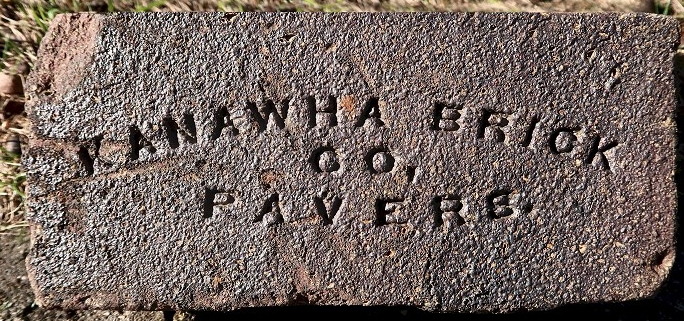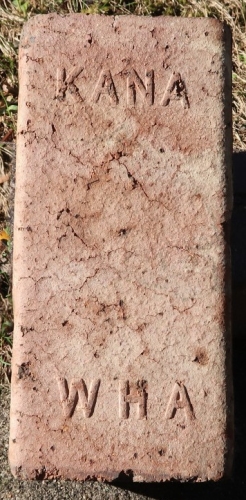BRICK
Most people have NO idea how important brick making was to Charleston and the United States.
We had some of the best clays in the world right here. Our brick went
all over the Eastern Seaboard, from NY, NJ, and Philadelphia for housing
projects. From Chicago to Florida for homes and buildings of all kinds.
Henry Ford bought all the brick we could make, especially
fire brick. Our brick went to build the Kraft Cheese Co., the Eastman
Kodak company, the Cincinnati Airport, the Cincinnati Kroger Warehouse,
the Ponce De Leon Hotel in Roanoke Va, not to mention thousands of homes
and buildings, like the Daniel Boone Hotel locally. We had 3
main plants: The Elk 2 Mile plant that was still operating when I was
young, the Kanawha 2 Mile plant, which had an overhead conveyor that
crossed 7th Ave, and the Elkland Brick Company which was located where
the entrance to Coonskin Park is today. They mostly made important fire
brick for the thousands of companies like Ford who needed it for their
furnaces.
|
WV Brick Company
(West Virginia Clay Products - Charleston Fire Brick Company)
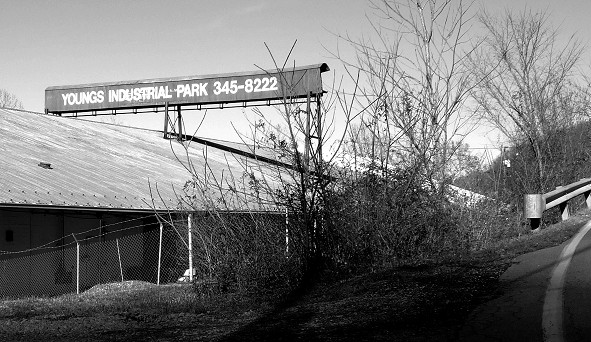
| Homer
Wiseman owned the WV Brick Company for many years; then it was
passed on to Clyde Wiseman and Claude Wiseman. The made face
brick and fire brick, but eventually they couldnt produce both in
enough quanity, so they gave the fire brick business to the Elkland
company just up the river at what is now Coonskin Park. They also
had
a plant in Barboursville. The Elk Two Mile plant was liquidated in
about 1970. The plant property covered the mountain which
now includes Northgate Park. |
| Along the Elk River on Barlow Drive is
a complex that once had several names and in fact, opened and closed
several times over it's history. We just called it "the
old brick plant". I can remember hauling as many "rejected"
brick as my red wagon could carry from this plant to Smith street.
The load was so heavy that by the time I got home, all the rubber
tires had come off the wagon. The photo above shows part of
the old original conveyor belt that ran from the plant across the
road, then up the hill to where the clay mine entrance was.
Just above that is a nice sized pond. |
LETS TAKE A LOOK AT THIS PLANT IN THE
LATE 40S, STARTING WITH THE MINE
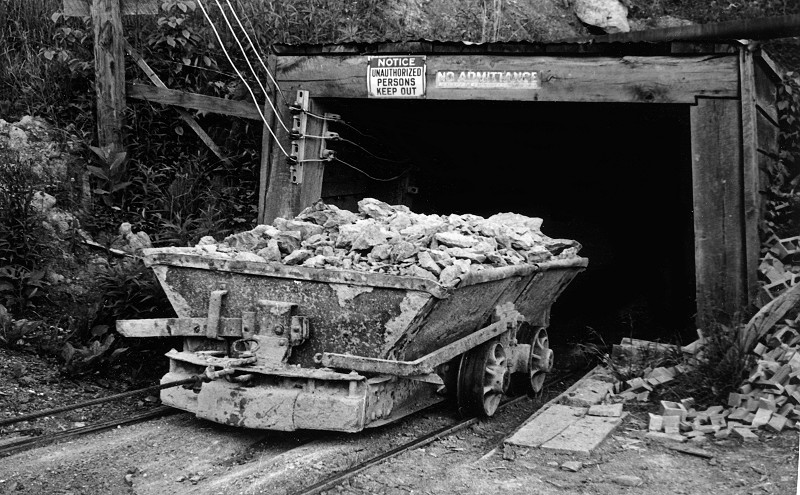
| The old clay mine entrance. I
have been here many times and have actually gone inside for some distance
before the water and obvious slate fall turned me around. It
now has a metal gate blocking the entrance and is hard to get to. |
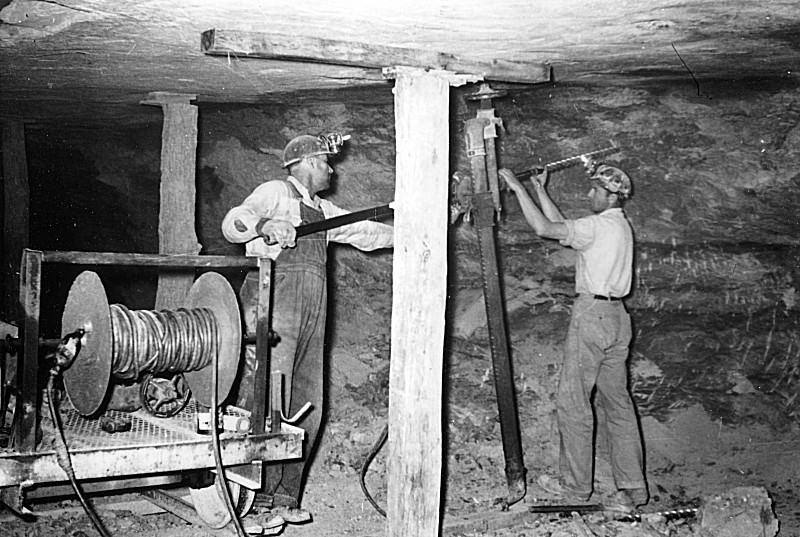
Men drilling the clay. Other
than not being as dirty, clay mining is pretty much just like coal
mining.
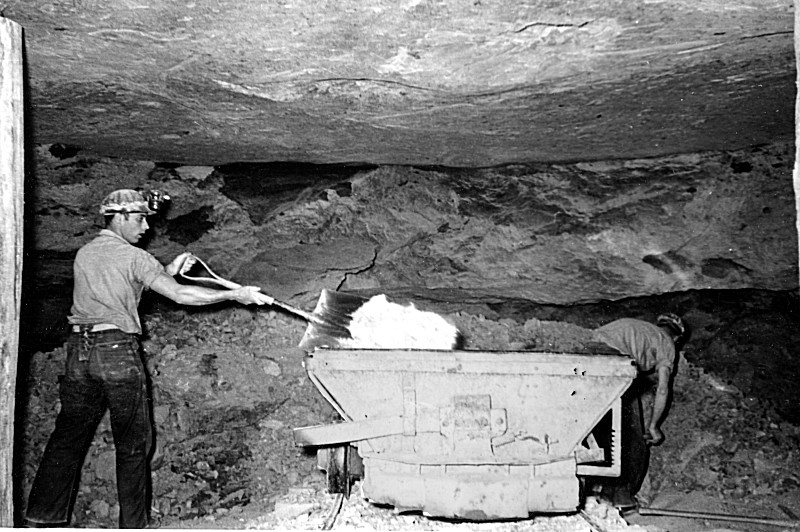
Few clay mines around here were as
automated as the coal mines at the time.
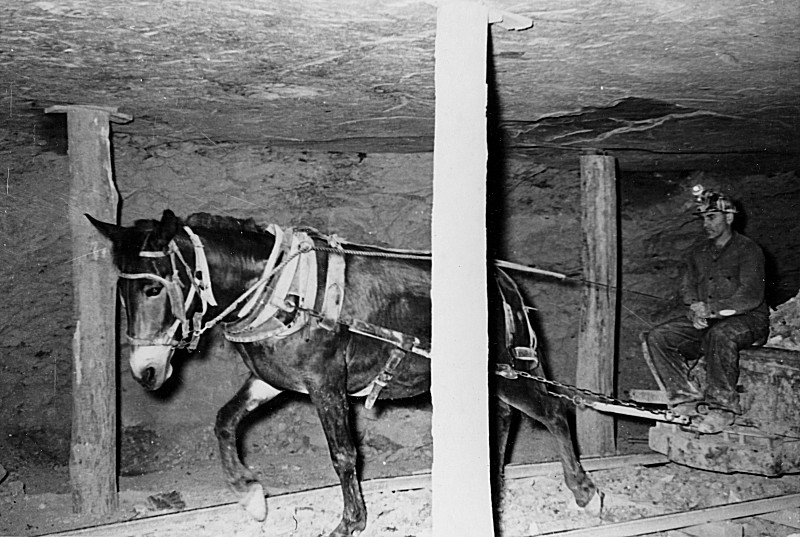
Even in the late 40s, Mules were still used
here for their cost effectiveness.
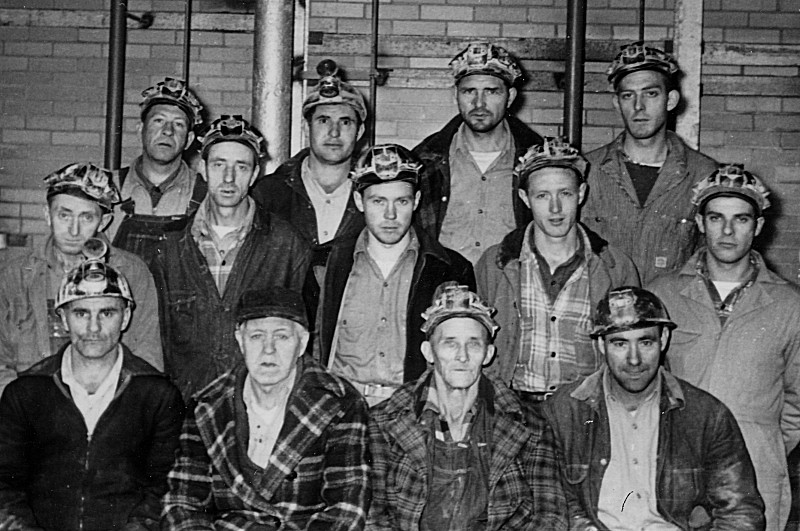
The clay miners. One might be your father or grandfather,
especially if you lived near the plant.
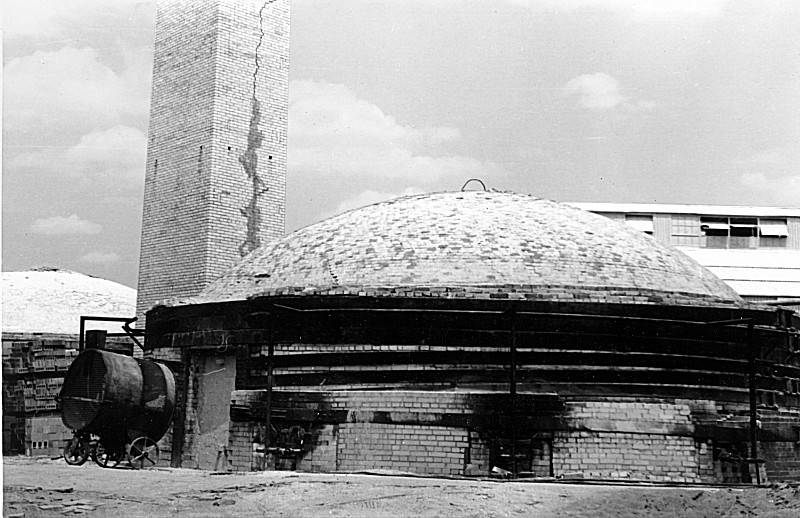
This is one of the kilns where the brick was baked.
Most brick made here was fire brick shipped out of state.
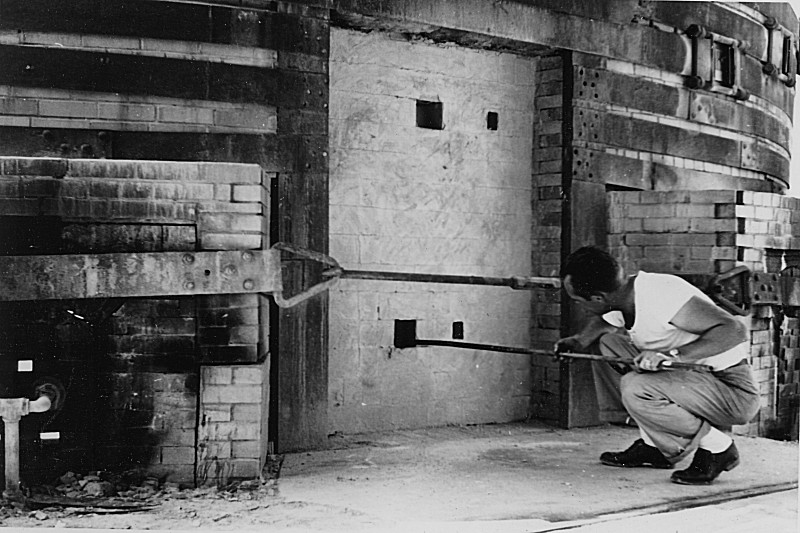
Checking the "glory hole" for heat.
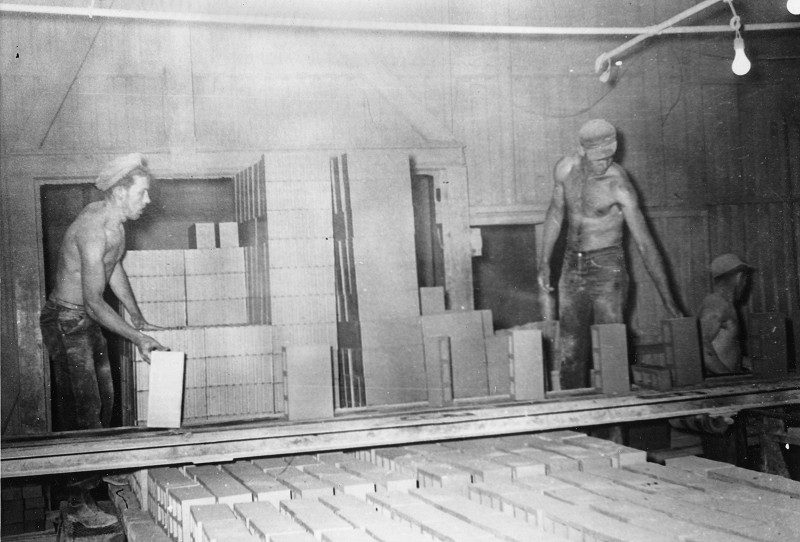
Working with small block here in a very hot environment.
I doubt OSHA would approve today.
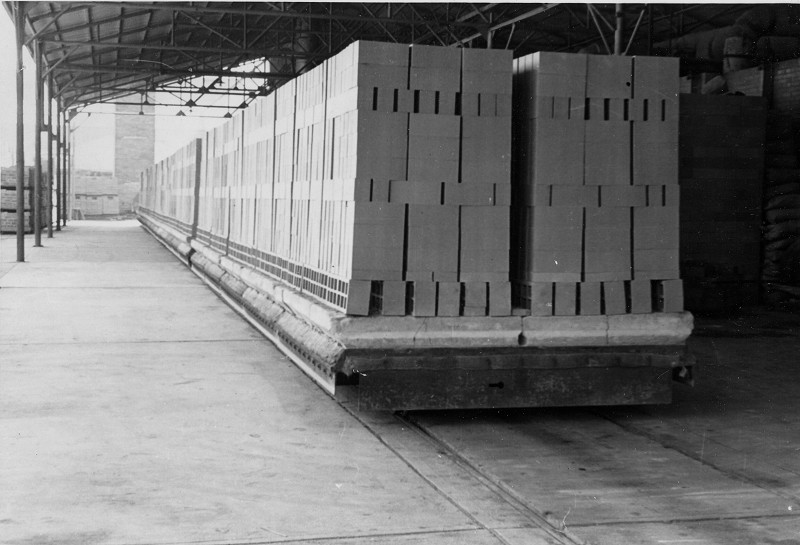
Hardened block ready to transport.
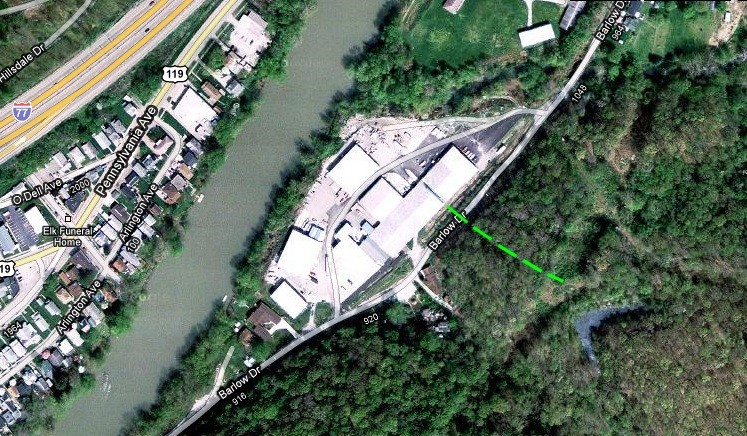
The green line shows the old conveyor route up the
hill to the mine. You can also see the pond just above it. 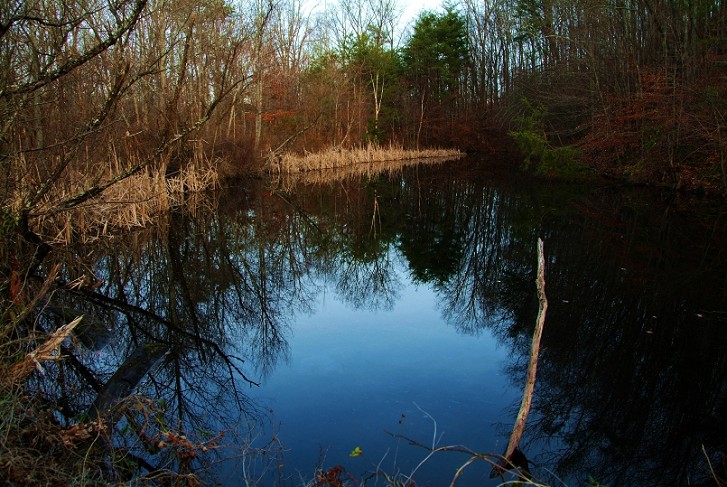
This is a shot of the pond that I took a couple of
years ago.
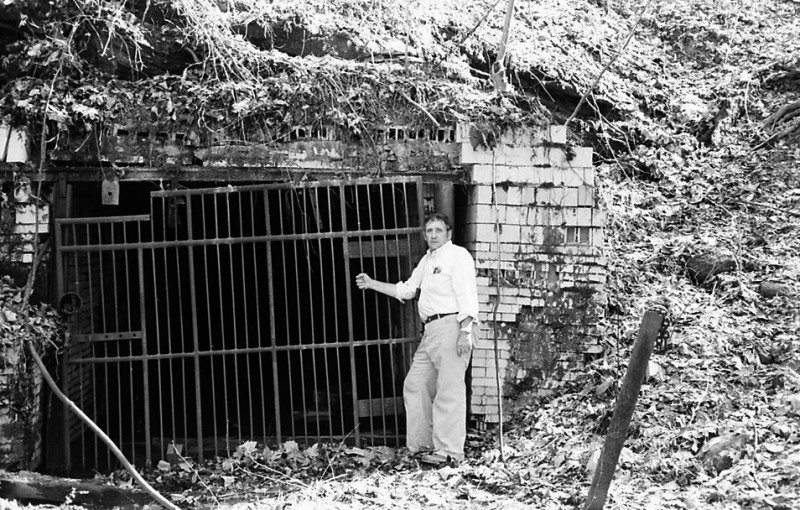
This is my friend Danny Davidson on one of his many trips to the old clay mine entrance.
If you're the least bit interested in learning more
about the local clay mines.... ELKLAND FIRE BRICK COMPANY 1927 Later Charleston Vitreous Clay Products Company.. specializing in glazed building tiles 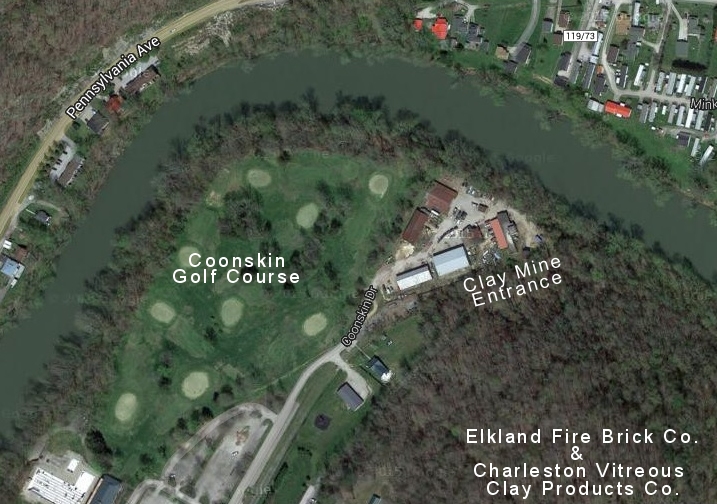
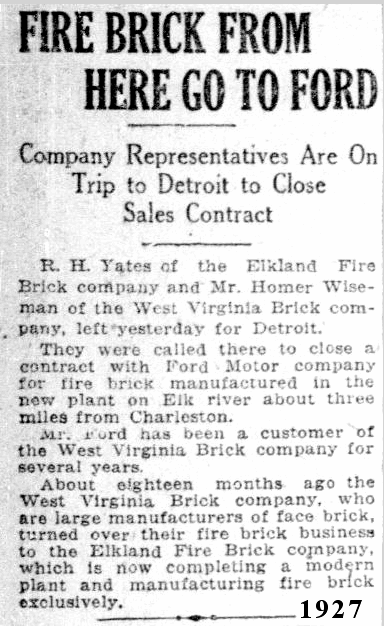
Henry
Ford got much of his materials to build cars and factories from West
Virginia. He bought coal and coal mines to heat his furnaces and
to make steel. He also needed brick, both to build his
factories and to build his ovens. Most of that brick came from
right here on the Elk River, because it was considered the finest clay
of its kind. The fire brick was of exceptional quality, and so he
purchased the entire production.
|
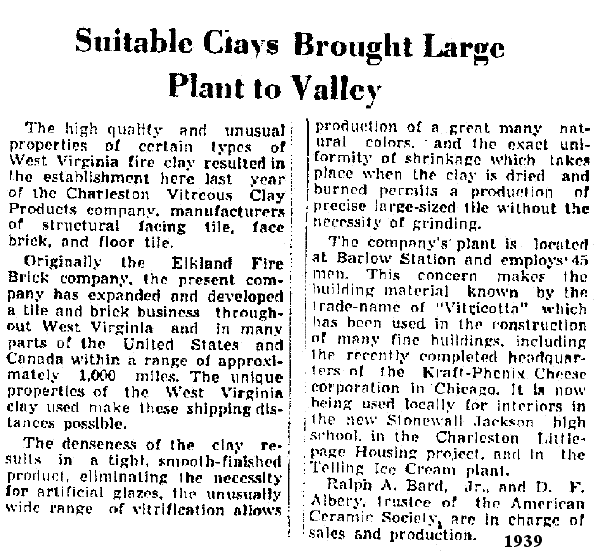 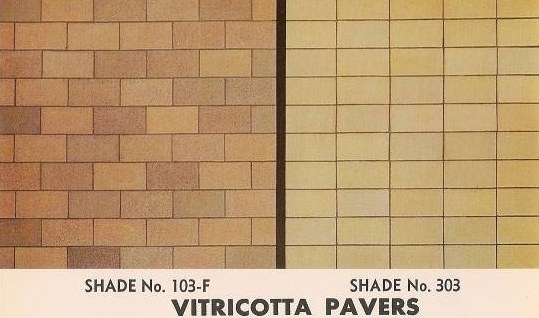
This
is a color sample of the tiles they made. If you look around
Charleston and beyond, you will see this product in just about
every old school and office building built here in the last 100 years.
They also made white and blue wall and floor tiles, fire brick, and 10 colors of regular building brick.
|

The
photos above were taken at the old Elkland mine area in 2015.
Shafts, bits of machinery and broken tile still litter the
landscape. Most of Coonskin Park sits atop a large labyrinth of
clay mine shafts.
|
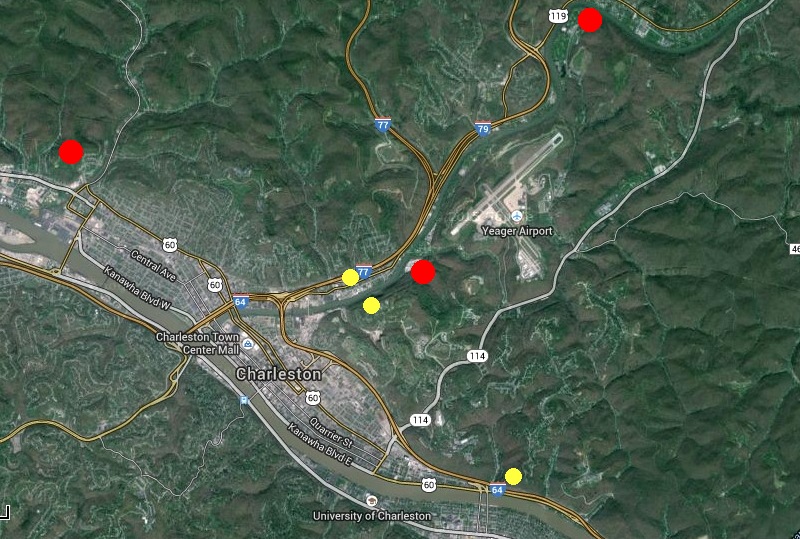
This map shows the main clay mines in red, while the yellow represents clay surface operations.
THE RALPH BARD STORY Ralph Austin Bard (July 29, 1884 – April 5, 1975) was a Chicago
financier. His son wrote the following:
In 1939, my father asked me if I
would like to help rescue a difficult investment he and others had
made in a tile and brick plant in Charleston, West Virginia, which was losing $25,000
per month. So we moved east. After observing operations for a month,
I decided that I understood the business and fired the plant manager,
the sales manager and several others, and took over all their jobs.
All losses stopped, but my wife and family saw little of me for two
years, and I became very unpopular with the CIO. and the United Mine
Workers. At one time, two C.I.O. agents tried to push me into
a hot kiln and later a miner arranged to drop a large chunk of clay
on my head in our deep mine. In 1941 with one more child, a
son, we left Charleston Clay Products, leaving the company in good
hands.
World War II changed all our lives. My father, Ralph A. Bard was
Assistant Secretary of the Navy (later Undersecretary) and because
of this I didn't want to accept a commission in the armed services,
but I did want to participate. I enlisted in the Marine Corps as a
private and went to boot camp at Parris Island....
After the war, I figured it was a
perfect time to be self-employed. Rawleigh Warner, Jr. (1944) and
I formed our own company, Warner-Bard, and had an interesting time
finding financial backing to launch people with new ideas and inventions,
some good and some terrible. Rawleigh left to work in the oil business
and, later, became Chairman and C.E.O. of Mobil Oil. In Barrington
Hills, outside of Chicago, we added another daughter to our family.
I visited Charleston Clay Products and was surprised to find large
shipments of tile going to Toronto - too far for us to ship before
the war. I went to Toronto to see why, and was amazed at the enormous
growth and opportunities there. Oil had been discovered in 1946, and
there was a ferment of oil and mining exploration. I was fortunate
to meet some of the mining, oil and banking leaders of Canada and,
eventually, organized an investment company with backing from some
of them and U.S. investors. Pretty exciting times ! |
More... From the West Virginia Geological and
Economic Survey, 1905
| In Kanawha county, in 1905, there were
three brick plants, manufacturing building and paving brick in the
city of Charleston: The W. Va. Clay Products Company, The Standard
Brick Company and The Kanawha Brick Company. Most would continue to
be worked into at least the 1950s. |
West Virginia Clay Products Company.
| "The plant of this company was built
near the close of the year 1902, two and one-half miles west of Charleston
on the Kanawha & Michigan railroad. The plant was a very substantial
one, with a large equipment of machinery, housed in large and well
constructed buildings. The cars were hauled from the mine by electric
trolley and the buildings lighted by electricity. It was one of the
most expensive plants in the State, but was destroyed by fire in the
fall of 1904 and has not been rebuilt. It manufactured fire brick,
building brick and a very high quality of paving block. The destruction
of the plant was a great loss to the brick industry of the State. |
West Virginia Clay Products Company
Mine Two This plant was formerly the Charleston
Fire Brick Company, and on pages 231-233 of Vol. Ill, West Virginia
Geological Survey, the following description is given:
"The plant of this company is
located up Elk river two miles from Charleston at Two Mile creek station
on the Coal & Coke railroad. It is one of the old brick yards
of the Charleston region, and has been used from time to time for
the manufacture of fire brick, but it has been idle since 1901. During
that year 1,500,000 fire brick were made for the coke ovens of the
*Kay Coal Company.
"The capacity of the plant is
25,000 bricks a day. The plant is equipped for the manufacture of
stiff-mud building brick, though none has been made for some years.
The equipment consists of a nine-foot dry pan, six-foot wooden pug
mill, Bucyrus auger of 30,000 capacity, Eagle repress. The building
bricks were dried in minetrack tunnel drier heated by fires below.
The fire brick were dried on a heated floor large enough to hold 10,000
brick. The building brick were burned in one up-draft kiln, and the
fire brick in two round down-draft kilns, 26 feet in diameter, drawing
into one stack.
"The river clay from a ten-foot
pit near the mill was used for building brick. The fire brick were
made from a mixture of one third flint clay and about two-thirds plastic
clay from the mine on the hill back of the plant.
"Clay Mine.—The clay
is worked in an open pit one mile and a half from the plant on Elk,
and 180 feet above the level of the plant. This mine could be reached
by wagon road and the clay was formerly hauled to the plant by this
route. Later a track was built from the mine around the hill to an
incline by cable and across the railroad on raised trestle to be dumped
at the mill. This track is now in bad repair but could be renewed
at no great cost.
"Some of the best fire brick
in the State were made for a number of years on Elk river, just above
Charleston, but at the present time no fire brick are made in this
vicinity. Near Charleston are located some deposits of fire clay equal
to the best in the State, and to be favorably compared with standard
fire clays of the Eastern states. These shales and clays make paving
brick of the highest quality, and the deposits are almost unlimited.
They burn both buff and red, making fine grades of pressed and ornamental
building brick. Here also occur fine grained clays adapted to manufacture
of pressed brick and tile, also good stoneware clays.
*Vol. Ill W. Va. Geological Survey,
1905. |
Kanawha Brick Company
Section 1 was 1.3 Miles east of Charleston, at Mine of Kanawha Brick
Company.
Section 2 was on the Elk River, the plant being at 1600 Penn. Ave.
"At the plant of this company,
one mile east of town on the Kanawha river, ten feet of river clay
is worked, as well as the hard clay from the hills above. The equipment
of the plant has been described in the preceding chapter with a description
of the hillside clays. The river clay has been used since 1897 in
the manufacture of red building brick and is burned in three up-draft
kilns.
"This company has another yard
on Elk river, one mile from Charleston, which was started by Mr. Isaacs
seventeen years ago. The clay is ground in a Potts crusher, tempered
in a twelve-foot pug mill and molded on an auger machine of 40,000
capacity, making 25,000 brick daily. The brick are dried in an eight-track
steam tunnel drier, holding 72 cars, with 45,000 capacity. The brick
are burned in one down-draft kiln, 28 feet in diameter, holding 60,000,
and three updraft kilns, 21 arch, holding 360,000 each, and burned
with gas.
"The river clay is 15 feet thick
in this pit and is hauled in cars by cable to the plant. The first
paving brick probably used in the United States were made from the
Kanawha Valley river clays at a point further down the river, by Mr.
Isaacs.
"In the Charleston region
there have been a number of brick plants in operation at various times,
a number of which have been unsuccessful on account of poor business
management rather than on account of the quality of the clays. The
first brick paved street in the United States was laid in Charleston
in 1872. One block of Summers street, nearest the Kanawha river, was
paved with brick set on sand, with a substructure of planks dipped
in tar and also resting on sand. This block is still in use, and the
street at this day is in very fair condition. For a number of years
after that date, the Charleston brick was shipped into Ohio, and the
first brick paved street in Columbus in the early1880's was laid with
the Charleston brick, set on tarred planks.
"With the opening of the paving
industry in Ohio, the sale of Charleston brick was confined to the
State, and in later years they were used mainly for local trade, very
few paving brick being shipped away. At the present time no paving
brick are made at Charleston.
This clay is also found on the other creek valleys near Charleston,
and on Ferry Branch on the south side of the Kanawha river, opposite
the mouth of Elk river, where the clay is exposed along the road leading
from Kanawha river to Sugar Camp creek of Davis creek, and is about
10 feet thick, 120 feet under the Ames limestone horizon.
|
The Standard Brick Company.
Clay was once mined near the mouth of
the Kanawha Two Mile Creek by the Kanawha and New River Fire Brick
Company, on the west side of the Sissonville road.
The Kanawha and New River Fire Brick
Company once manufactured brick in Charleston, but the plant is now
abandoned, as it was destroyed by fire in 1904, and has been rebuilt
as the Standard Brick Company. The following is a short description
of the original plant and mine given in Vol. IIl, pages 229-231, W.
Va. Geological Survey, 1905:
"The plant of this company was built
near the close of the year 1902, two and one-half miles west of Charleston
on the Kanawha & Michigan railroad. The plant was a very substantial
one, with a large equipment of machinery, housed in large and well
constructed buildings. The cars were hauled from the mine by electric
trolley and the buildings lighted by electricity. It was one of the
most expensive plants in the State, but was destroyed by fire in the
fall of 1904 and has not been rebuilt. It manufactured fire brick,
building brick and a very high quality of paving block. The destruction
of the plant was a great loss to the brick industry of the State.
"The equipment consisted of two
nine-foot Stevenson dry pans, one Martin wet pan, twelve-foot plug
mill, Freese auger brick machine (Mammoth Junior) of 75,000 capacity,
two Raymond represses. The brick were dried in a hot air tunnel drier
of eight tunnels, with capacity of 75,000 bricks. The fire brick molded
by hand were dried on a floor above the drier tunnels. Hot air was
forced into the drier by a large fan. The brick were burned in eight
round down-draft kilns, 28 and 30 feet in diameter, holding 40,000
blocks, and in five square down-draft kilns, holding 70,000 blocks.
The clay mine is located at the side
of the county road, over one-half mile north of the plant, and is
opened by three entries. "The fire clay and associated mottled
clays are found one mile east, by the road side and up Woodward creek,
(now Woodward Drive) and of apparently the same quality. Along this
creek is a deposit of pottery clay which has not been developed. "The
shales found on Two Mile creek and used by the Kanawha and New River
Brick Company were traced into the hills to the east near the Hannah
farm as described in an earlier section. Shales of the same horizon
were found at Barlow a few miles up Elk river, on the McDonald farm
about 80 feet above the blue clay described above, from the same farm.
|
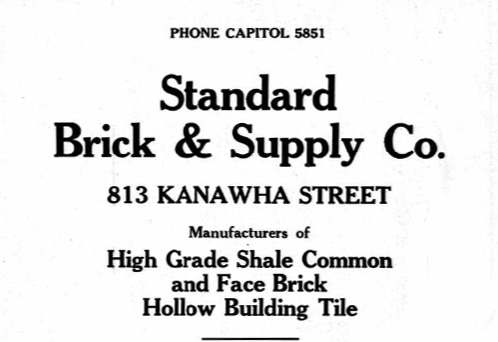
Old photos courtesy of Steve
Fox
SIDE NOTE: 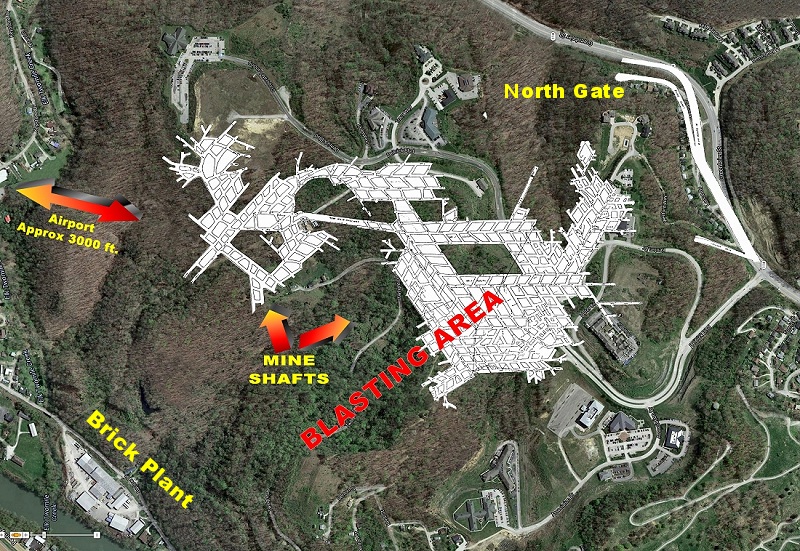 In
March of 2015, the end of Yeager Airports runway over-run collapsed.
It was the highest "Fill" of its type in the United States and had been in place for
years. About a year earlier, the airport authority discovered
cracks in the top of the fill. At about that same time,
contractors were blasting away at a hill in front of and slightly
to the left of the main runway in order to lower that obstacle for
takeoff. This blasting was very close to, and in some cases over
top of the clay mine shafts. Is it possible that the huge voids
underground acted like a drum, amplifying the vibrations to the airport
runway about 3000 feet away? Of course as mentioned, this was
the highest fill of its kind, and the harsh winter and then heavy
rains certainly contributed to its failure. But could the
blasting over the mines have contributed also? ( The map above is
showing the mine shafts in white, which you can see cover a large area.
This map is approximate, and not to be considered exact... but
it's very close)
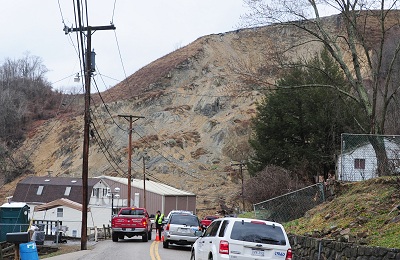 Yeager Airport Overrun Collapse. Yeager Airport Overrun Collapse.
|
|
CLAYS, ROAD MATERIALS, BUILDING STONES,
Professor G. P. Grimsley in Vol. Ill of the State Geological Survey
Reports gives a general review of the clay industry in West Virginia,
along with a discussion of the origin, physical and chemical
properties, and classification of clays and their uses, to which the
reader is referred for interesting data, and the technology of the
industry. The following quotation from this volume is pertinent:
"In the Charleston region there have been a number of brick plants in
operation at various times, a number of which have been unsuccessful on
account of poor business management rather than on account of the
quality of the clays. The first brick paved street in the United States
was laid in Charleston in 1872. One block of Summers street, nearest
the Kanawha river, was paved with brick set on sand, with a
substructure of planks dipped in tar and also resting on sand. This
block is still in use, and the street at this day is in very fair
condition. For a number of years after that date, the Charleston brick
was shipped into Ohio, and the first brick paved street in Columbus in
the early 80's was laid with the Charleston brick, set on tarred planks.
"With the opening of the paving industry in Ohio, the sale of
Charleston brick was confined to the State, and in later years, they
were used mainly for local trade, very few paving brick being shipped
away. At the present time no paving brick are made at Charleston.
"Some of the best fire brick in the State were made for a number of
years on Elk river, just above Charleston, but at the present time no
fire brick are made in this vicinity. Near Charleston are located some
deposits of fire clay equal to the best in the State, and to be
favorably compared with standard fire clays of the Eastern states.
These shales and clays make paving brick of the highest quality, and
the deposits are almost unlimited. They burn both buff and red, making
fine grades of pressed and ornamental building brick. Here also occur
fine grained clays adapted to manufacture of pressed b*rick and tile,
also good stoneware clays.
"The area of these clays is large, and their location is close to the
Great Kanawha Valley coal fields, and gas fuel Is also available. Three
lines of railroads reach the field, and the Kanawha furnished water
transportation for fuel and for the finished product. With all these
natural advantages, the Charleston region should be the greatest center
of clay industries in the State, but at the present time there are only
three small yards using the river clays and one yard using the clay
mined In the hill.
"It is difficult to explain the causes of the non-development of this
field. There have been some discouraging failures in plants In this
region, but in no case have they been due in any degree to the
character of the claye. It is hoped that when the natural advantages of
this region for clay working in its different lines are fully
appreciated capital will come in to develop the field properly Clay
products should be shipped out of this territory to supply the trade
not only of West Virginia, but of the cities east, south, and even
west. A careful examination of the results of the investigation of
these clays now to be given, will show their high character, and their
location, in part. It must be remembered that the report of these
Charleston clays is not complete, and there probably exists other
important deposits that were not visited in the course of this
investigation. The clays which have been developed near Charleston
belong to the Conemaugh Series and the Upper Kanawha Series."
In Kanawha county, at this time, there are three brick plants,
manufacturing building and paving brick in the city of Charleston: The
W. Va. Clay Products Company, The Standard Brick Company and The
Kanawha Brick Company.
West Virginia Clay Products Company.
This plant was formerly the Charleston Fire Brick Company, and on pages
231-333 of Vol. III, West Virginia Geological Survey, the following
description is given:
"The plant of this company is located up Elk river two miles from
Charleston at Two Mile creek station on the Coal & Coke railroad.
It is one of the old brick yards of the Charleston region, and has been
used from time to time for the manufacture of fire brick, but it has
been idle since 1901. During that year 1,500,000 fire brick were made
for the coke ovens of the Kay Coal Company.
"The capacity of the plant is 25,000 bricks a day. The plant is
equipped for the manufacture of stiff-mud building brick, though none
has been made for some years. The equipment consists of a nine-foot dry
pan, six-foot wooden pug mill, Bucyrus auger of 30,000 capacity, Eagle
repress. The building bricks were dried in mine track tunnel drier
heated by fires below. The fire brick were dried on a heated floor
large enough to hold 10,000 brick. The building brick were burned in
one up-draft kiln, and the -fire brick in two round down-draft kilns,
26 feet in diameter, drawing into one stack.
"The river clay from a ten-foot pit near the mill was used for building
brick. The fire brick were made from a mixture of one third flint clay
and about two-thirds plastic clay from the mine on the hill back of the
plant.
"Clay Mine.—The clay is worked in an open pit one mile and a half from
the plant on Elk, and 180 feet above the level of the plant. This mine
could be reached by wagon road and the clay was formerly hauled to the
plant by this route. Later a track was built from the mine around the
hill to an incline by cable and across the railroad on raised trestle
to be dumped at the mill. This track is now in bad repair but could be
renewed at no great cost.
"The clay pit has caved along the banks and the talus covers the flint clay over much of its surface.
The Standard Brick Company.
The Kanawha and New River Fire Brick Company once manufactured brick in
Charleston, but the plant is now abandoned, as it was destroyed by fire
in 1904, and has been rebuilt as the Standard Brick Company. The
following is a short description of the original plant and mine given
in Vol. Ill, pages 229-231, W. Va. Geological Survey, 1905 :
"The plant of this company was built near the close of the year 1902,
two and one-half miles west of Charleston on the Kanawha & Michigan
railroad. The plant was a very substantial one, with a large equipment
of machinery, housed in large and well constructed buildings. The cars
were hauled from the mine by electric trolley and the buildings lighted
by electricity. It was one of the most expensive plants in the State,
but was destroyed by fire in the fall of 1904 and has not been rebuilt.
It manufactured fire brick, building brick, and a very high quality of
paving block. The destruction of the plant was a great loss to the
brick industry of the State.
"The equipment consisted of two nine-foot Stevenson dry pans, one
Martin wet pan, twelve-foot plug mill, Freese auger brick machine
(Mammoth Junior) of 75,000 capacity, two Raymond represses. The brick
were dried in a hot air tunnel drier of eight tunnels, with capacity of
75,000 bricks. The fire brick molded by hand were dried on a floor
above the drier tunnels. Hot air was forced into the drier by a large
fan. The brick were burned in eight round down-draft kilns, 28 and 30
feet in diameter, holding 40,000 blocks, and in five square down-draft
kilns, holding 70,000 blocks. These blocks were made 8%x2%x4 inches in
size.
"Clay Mine.—The clay mine is located at the side of the county road,
over one-half mile north of the plant, and is opened by three entries.
Kanawha Brick Company.
On pages 262-264 of Vol. Ill of the same report the following
description is given of the Kanawha Brick Company. A section of this
mine has already been given on page 180 of this report.
"At the plant of this company, one mile east of town on the Kanawha
river, ten feet of river clay is worked, as well as the hard clay from
the hills above. The equipment of the plant has been described in the
preceding chapter with a description of the hillside clays. The river
clay has been used since 1897 in the manufacture of red building brick
and is burned in three up-draft kilns.
"This company has another yard on 131k river, one mile from Charleston,
which was started by Mr. Isaacs seventeen years ago. The clay Is ground
in a Potts crusher, tempered in a twelve-foot pug mill and molded on an
auger machine of 40,000 capacity, making 25,000 brick daily. The brick
are dried in an eight-track steam tunnel drier, holding 72 cars, with
45,000 capacity. The brick are burned In one down-draft kiln, 28 feet
in diameter, holding 60,000, and three updraft kilns, 21 arch, holding
360,000 each, and burned with gas.
"The river clay is 15 feet thick in this pit and is hauled in cars by
cable to the plant. The first paving brick probably used In the united
States were made from the Kanawha Valley river clays at a point further
down the river, by Mr. Isaacs.
"Chemical Composition.—The clay from the Kanawha Brick Company yard on
the Kanawha river above Charleston, and the yard on Elk river were
analysed, showing the following composition:
John S. McDonald Fireclay.
Fireclay crops on the John S. McDonald farm at Barlow, in a railroad cut, about yż mile above Barlow Station.
The shales found on Two Mile creek and used by the Kanawha and New
River Brick Company were traced into the hills to the east near the
Hannah farm as described In an earlier section. Shales of the same
horizon were found at Barlow a few miles up Elk river, on the McDonald
farm about 80 feet above the blue clay described above, from the same
farm. Fifteen feet of shales are exposed to the top of the hill, with
heavy sandstone below. The horizon of these shales is that of the
Pittsburgh red shale, the same as at Morgantown.
"Both of these shales near Charleston turn red, making a high grade
building brick, and are accessible to the rail road. The McDonald shale
is only a short distance from the Coal & Coke rail road, while that
on the Hannah farm is about one-half mile from the Kanawha &
Michigan road. Neither deposit has been developed, though both have
been tested in a practical way in the local brick yards with marked
success. The analyses of these shales show a close resemblance to the
Morgantown shale, except they have a higher percentage of ferric iron
Coal and Coke Railroad Quarry at Charleston
"A large sandstone quarry was opened a number of years ago a short
distance up Elk river from Charleston to supply stone for the locks and
dams on the Kanawha river. In April 1904 the quarry was opened to
supply ballast for the railroad and has been open since that time. It
is located at the side of the Coal and Coke railroad tracks in the Elk
river bluff one mile and a half northeast of Charleston, and is
operated by the railroad company. Seventy or eighty men are employed
and 250 to 300 yards of ballast quarried and crushed daily. At the
present time no building stone is quarried.
"The floor of the quarry is about 30 feet above Elk river, and a small
coal is found near the center of the quarry which is probably one of
the Allegheny coals. This sandstone forms the upper portion of the
Charleston sandstone of Campbell, or the Buffalo-Mahoning horizon and
probably a part of the Freeport.
"The stone is rather fine grained, blue or gray in color with mica
flakes through it. It breaks readily into blocks and shows foliation in
many ledges. These plants are often curved, but the curved lines
finally disappear in the solid stone.
"The face of the quarry runs northeast-southwest at an angle of nearly
45 degrees. It is 350 to 400 feet long, and worked back 40 to 60 feet.
Patrick Ryan Quarry at Charleston.
"One mile northeast of Charleston up a ravine a short distance 'from
the Coal and Coke quarry, Mr. Patrick Ryan operates a sandstone quarry
opened 20 years ago. Ten men are employed and two or three perch of
building stone sent out daily during the working season, also 100 to
200 tons of crushed stone for concrete. Its geologic horizon is the
same as at the Coal and Coke quarry.
"The sandstone is bluish gray in color, foliated with mica flakes. Some
of the stone is banded with wavy red lines due to iron stain, giving a
variegated color. In other ledges the stone is nearly pink in color,
and the calico stone is characterized by irregular wavy bands of yellow
and red through a buff or yellowish rock. The stone readily breaks
along the mica planes or along the red streaks. The bands are often
cross bedded and more or less curved. On account of the number of bands
or planes, the stone can be split into blocks of almost any desired
thickness, building blocks, curb, or flagging.
"Quarry.—The face of the quarry runs about 45 degrees northwest, 300
feet long, and worked back 30 to 40 feet. The quarry is located on Coal
Branch, and was formerly worked on both sides of the creek.
Savage Quarry at Charleston.
"Mr. P. M. Savage operates a quarry at north end of Capitol street near
the Coal & Coke railroad and the city of Charleston. This quarry is
one of the oldest quarries near this city, and the stone is used for
buildings and crushed for concrete. Twenty to thirty men are employed,
and 150 to 200 tons of stone are crushed daily in an Austin No. 5
crusher. The stone is said to weigh about 2,700 pounds to the cubic
yard.
"This sandstone comes at the horizon of the other Charleston quarries
described above. The rock is gray or bluish gray in color with
foliation planes through it, giving a banded appearance- The bands are
frequently cross-bedded, and the stone splits readily along these
planes. In the old exposed portion of the quarry, the stone has
weathered to a buff color, and at the north end it is shaly and badly
broken on outcrop.
"Through the rock occur nodules and streaks of coal, which are
especially abundant about 20 feet from the top of the quarry down to
near the base. The cracks and joint planes are coated with a brown
discoloration which sometimes extends a few inches into the stone from
the fissure lines, and is due to Iron in percolating surface waters.
Some of the blocks tend to break with a shelly fracture, giving curved
surface to the stone. In some parts of the quarry small, round, hard,
pebbles of quartz occur, also brown chert or flint fragments.
"Quarry.—The face of the quarry runs north and south, 170 feet long
with the old workings extending 80 feet further to the south. It has
been worked back to the east 75 to 80 feet.
|

Back to index
|
















